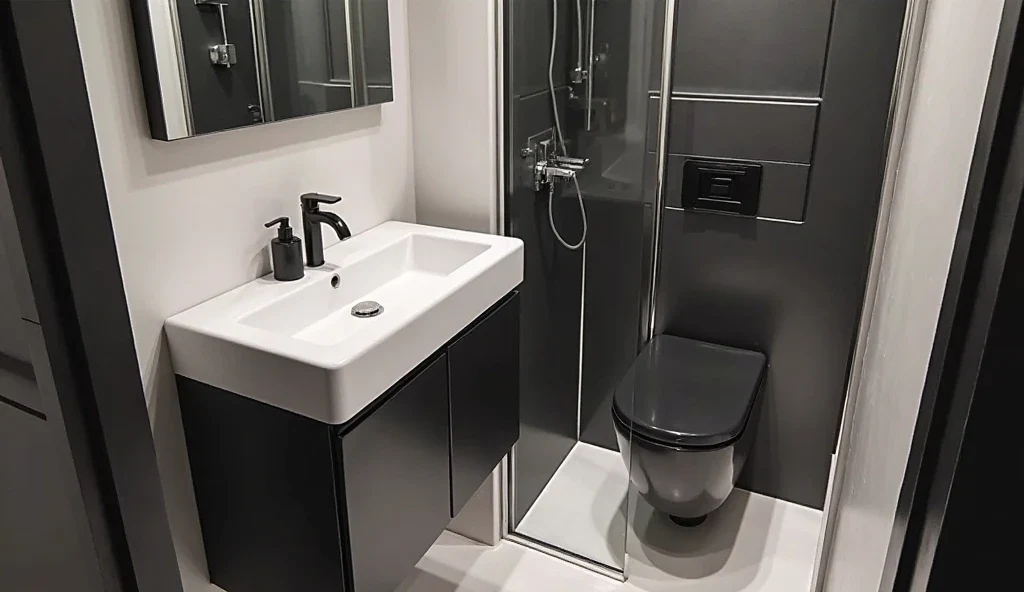Let’s be real—small bathrooms are the ultimate design challenge. You’ve got about the square footage of a closet, but somehow you need to fit a toilet, sink, shower, storage, and still make it look like something other than a cramped afterthought.
Maybe you’re dealing with a tiny powder room that you’re trying to squeeze a shower into, or that awkward half-bath under the stairs that feels more like a broom closet than a functional space. You scroll through Instagram looking at those gorgeous bathroom transformations and think “sure, but they probably started with a room the size of my bedroom.”
Here’s what nobody tells you: small bathrooms can actually be more stunning than large ones when you get the design right. There’s something incredibly satisfying about a tiny space that works perfectly—every inch intentional, every element earning its place.
The trick isn’t pretending your bathroom is bigger than it is. It’s about embracing the small space and making it so gorgeous and functional that you forget to wish it were larger. Ready to turn your bathroom from “barely functional” to “wow, how did you fit so much style in here?” Let’s dive in.
Master the Fundamentals of Small Space Design
Before we get into all the specific design ideas, let’s talk about the principles that actually make small bathrooms work. You can copy every gorgeous bathroom you see online, but if you ignore these basics, your space will still feel cramped and awkward.
Vertical Space is Your Best Friend – When floor space is limited, think up. Wall-mounted fixtures, floating vanities, and vertical storage free up precious floor area and make the room feel less cluttered.
Light Colors Expand Space – This isn’t just design folklore—light colors genuinely make small spaces feel larger by reflecting more light. Save the dark, moody colors for bigger bathrooms.
Every Element Must Earn Its Place – In a small bathroom, there’s no room for anything purely decorative. Every fixture, every storage solution, every design element needs to serve a purpose.
Consistent Materials Create Flow – Using the same tile or color palette throughout prevents the space from feeling chopped up and disjointed.
Think Like a Space-Planning Pro
The difference between a small bathroom that works and one that feels impossible to navigate isn’t luck—it’s smart planning. Professional designers use specific strategies that you can absolutely apply to your own space.
Plan Your Traffic Flow – You should be able to move from the door to each fixture without bumping into anything. If you’re doing bathroom gymnastics to use your space, something needs to change.
Corner Solutions Save Space – Corners are often wasted in small bathrooms, but they’re perfect for space-saving fixtures like corner sinks, corner showers, or corner storage.
Scale Matters More Than Style – A gorgeous vanity that overwhelms your space will make even the most beautiful bathroom feel cramped. Choose fixtures sized for your room, not your Instagram feed.
Storage Must Be Built In – Freestanding storage takes up floor space you don’t have. Built-in niches, wall-mounted cabinets, and integrated storage are essential.
Smart Layout Strategies
The layout is where small bathrooms live or die. You can have the most beautiful fixtures in the world, but if they’re arranged poorly, your bathroom will never feel right.
Door Swing Direction – Make sure your door swings out of the bathroom, not into it. Every inch of floor space counts, and you don’t want your door taking up precious room inside.
Sight Lines Matter – Position your mirror and lighting so you can see yourself clearly without awkward positioning. This makes the daily routine smoother and the space feel more functional.
15 Small Bathroom Design Ideas
Modern Micro Bathroom With Floating Fixtures
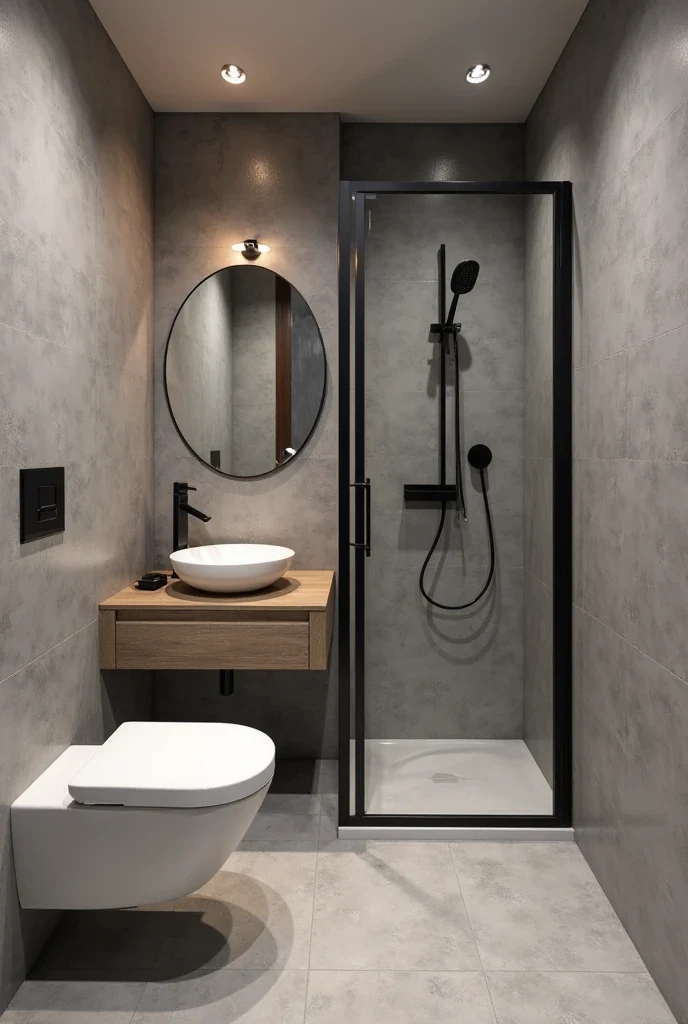
The genius of wall-mounted fixtures is how much visual space they create by showing the floor underneath. A floating toilet and vanity make even the tiniest bathroom feel less cramped because your eye can travel uninterrupted across the floor.
Choose sleek, minimal fixtures in a consistent finish—matte black is incredibly chic right now and hides water spots better than chrome. A corner glass shower with minimal framing keeps sight lines open while maximizing your shower space.
The key is keeping everything streamlined. No decorative elements that don’t serve a function, no unnecessary details that add visual clutter. Just clean lines and smart functionality.
Neutral-Toned Tiny Bathroom With Wood Accents
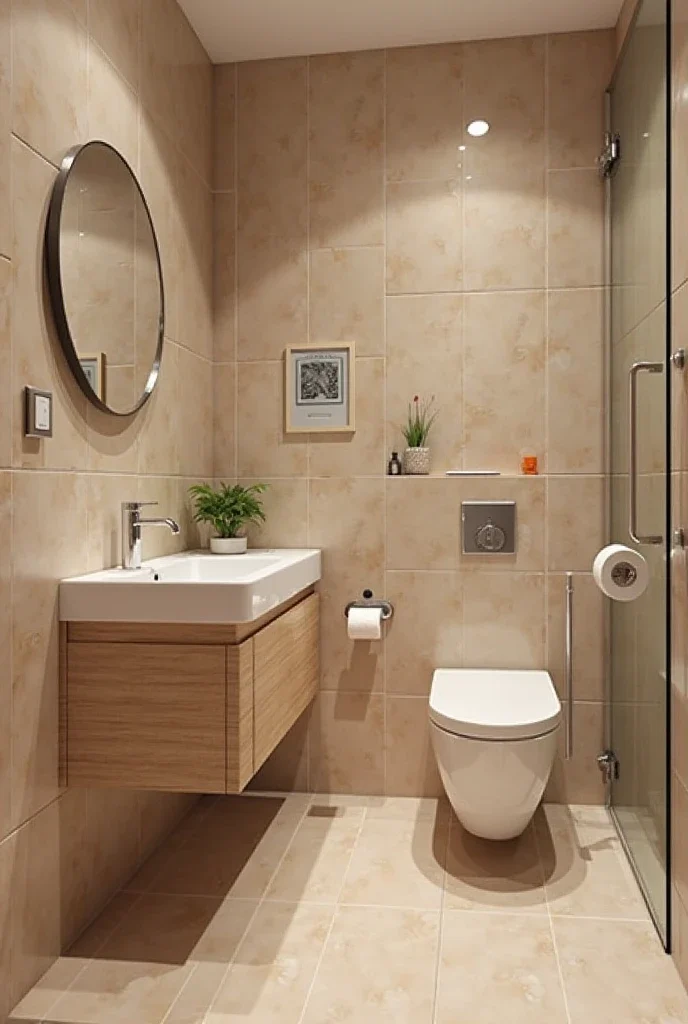
Warm neutrals with natural wood creates a spa-like feeling that makes small spaces feel cozy rather than cramped. Light oak or pine adds organic warmth without overwhelming the space with strong color or pattern.
A round mirror softens all the hard angles you’ll inevitably have in a small bathroom, while warm lighting makes the whole space feel inviting rather than utilitarian. The trick is balancing the wood tones with plenty of white or light colors to keep things bright.
This approach works especially well if your small bathroom doesn’t have a window. The warm tones compensate for the lack of natural light and create a welcoming atmosphere.
Industrial Small Bathroom With Urban Touch
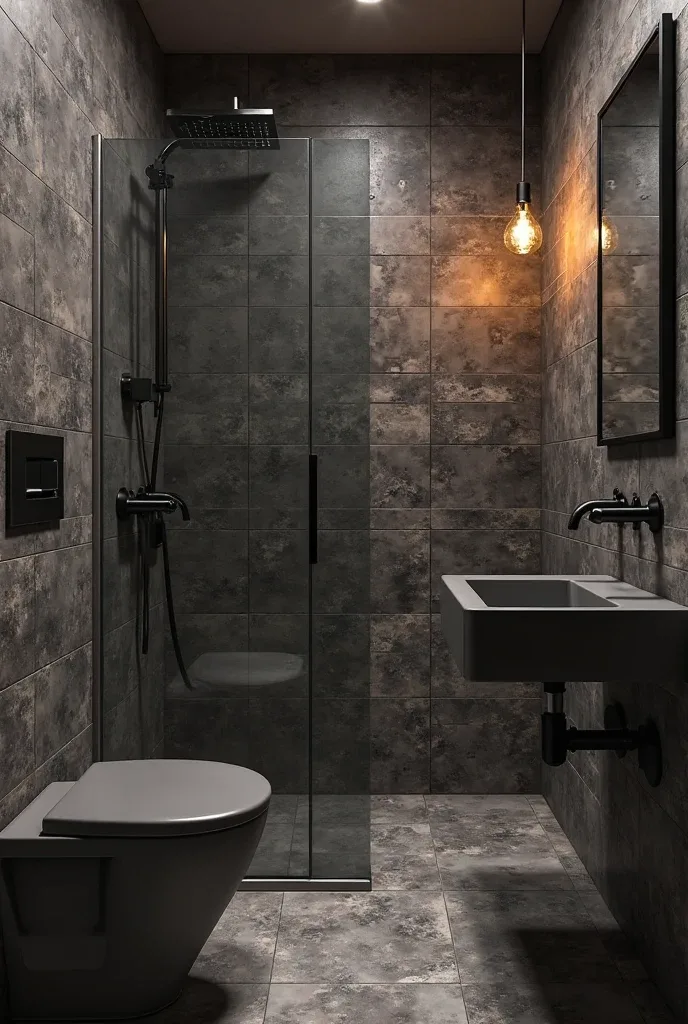
If you’re going to have a small bathroom, why not make it look intentionally edgy and cool? Dark materials and industrial elements can make a tiny space feel like a chic urban hideaway rather than a compromise.
Exposed plumbing becomes a design feature rather than something to hide, and matte black fixtures create a cohesive, sophisticated look. The key is keeping the lighting bright enough that the dark colors don’t make the space feel cave-like.
This style works particularly well in lofts, modern homes, or anywhere you want your small bathroom to feel like a design statement rather than an afterthought.
White Marble Compact Bathroom
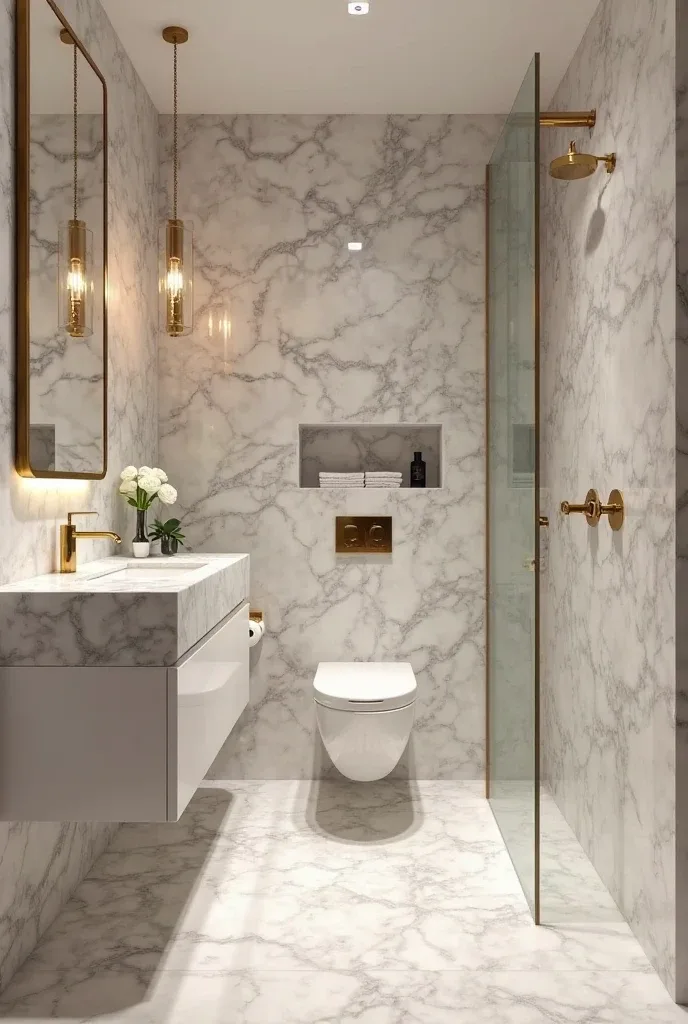
Nothing makes a small space feel more luxurious than beautiful materials, and marble instantly elevates any bathroom from basic to high-end. Using the same marble on walls and floors creates visual continuity that makes the space feel larger.
Gold fixtures add warmth and prevent the white marble from feeling cold or sterile. A floating vanity keeps the floor lines clean, while a frameless glass shower door maintains open sight lines.
The trick with marble in small spaces is keeping the veining subtle. Busy patterns can overwhelm a tiny room, while clean, minimal veining adds interest without chaos.
Scandinavian-Style Tiny Bathroom
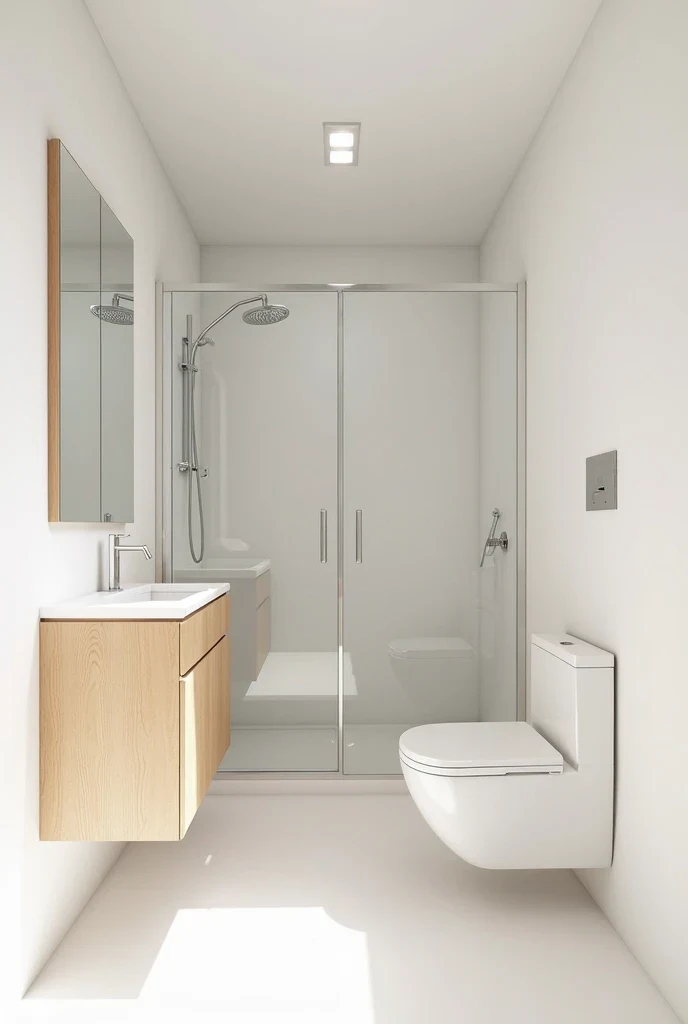
Scandinavian design was basically invented for small spaces, so it’s perfect for tiny bathrooms. The combination of white walls, light wood, and minimal fixtures creates a clean, peaceful feeling that never feels cramped.
Natural light is crucial for this look, so if you have a window, keep window treatments minimal. If you don’t have natural light, invest in excellent artificial lighting that mimics daylight.
The beauty of Scandinavian style is its simplicity. Every element is functional and beautiful, but nothing is unnecessary or over-designed. It’s the perfect approach for people who want their small bathroom to feel calm and uncluttered.
Boho-Inspired Small Bathroom With Textured Walls
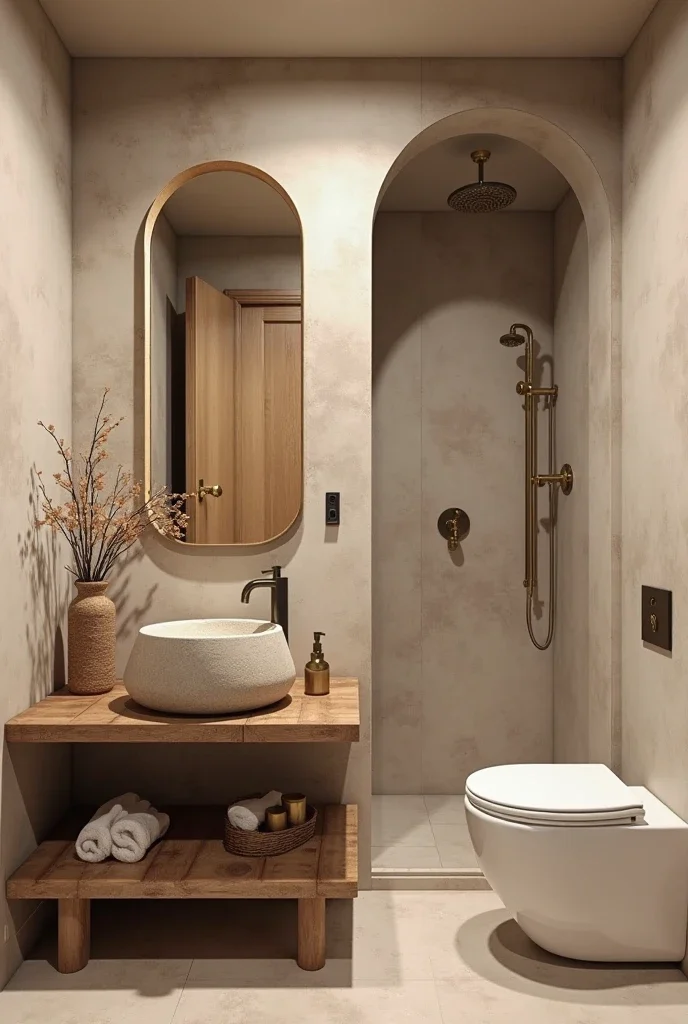
Who says small bathrooms have to be minimal? If you love texture and warmth, a boho-inspired approach can make a tiny bathroom feel like a cozy retreat. Textured plaster walls add visual interest without taking up any floor space.
A round stone basin on a rustic wood vanity brings natural materials and organic shapes that soften the hard edges of a small room. Brass fixtures add warmth and work beautifully with the earthy color palette.
The key is keeping the color palette cohesive—stick to warm neutrals and natural materials rather than introducing too many different colors or patterns.
Ultra-Narrow Bathroom With Vertical Storage

Sometimes you’re working with a space that’s more like a hallway than a room. In these super-narrow layouts, embrace the linear arrangement and make it work for you rather than fighting against it.
Arrange fixtures in a logical sequence—typically toilet, sink, then shower as you move deeper into the space. Use vertical wall space above the toilet for storage, and choose a pedestal sink to keep the floor area as open as possible.
The trick is making the narrow space feel intentional rather than cramped. Good lighting and light colors are essential, and every fixture should be scaled appropriately for the width of the room.
Monochrome Minimalist Tiny Bathroom
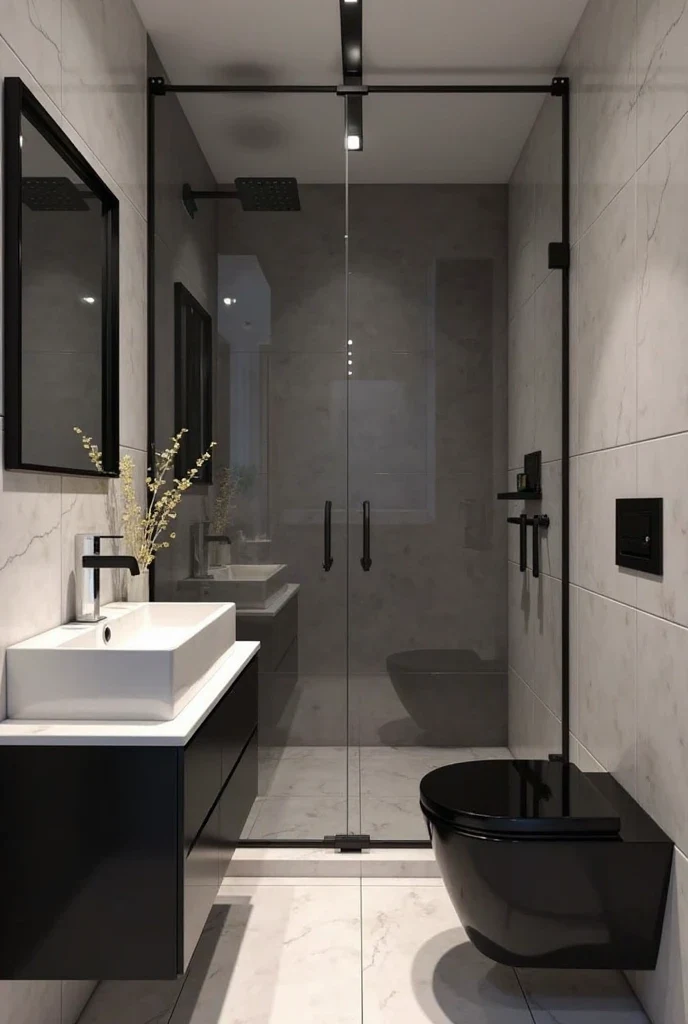
Black and white is always chic, and in a small bathroom, this high-contrast approach can create dramatic impact without overwhelming the space. The key is getting the proportions right—more white than black to keep things feeling bright and open.
A wall-hung vanity and toilet maximize floor space, while a frameless glass shower keeps sight lines open. The linear drain in the shower floor is both practical and adds to the clean, modern aesthetic.
This approach works especially well if you love modern design but want something that will never go out of style. Black and white is timeless, and the minimalist approach ensures the space will always feel current.
Tiny Powder-Style Bathroom With Shower

Sometimes you’re trying to add a shower to what was originally just a powder room, and the challenge is making everything fit without the space feeling impossible to use. The solution is choosing the smallest possible fixtures that still function well.
A wall-mounted sink takes up minimal space, while a compact toilet maximizes the available floor area for a small shower stall. Stone tiles add luxury and durability in a space where everything needs to work hard.
The round mirror softens the angular fixtures and reflects light to make the space feel larger. Brass accents add warmth and prevent the small space from feeling too utilitarian.
Retro Compact Bathroom With Vintage Tiles
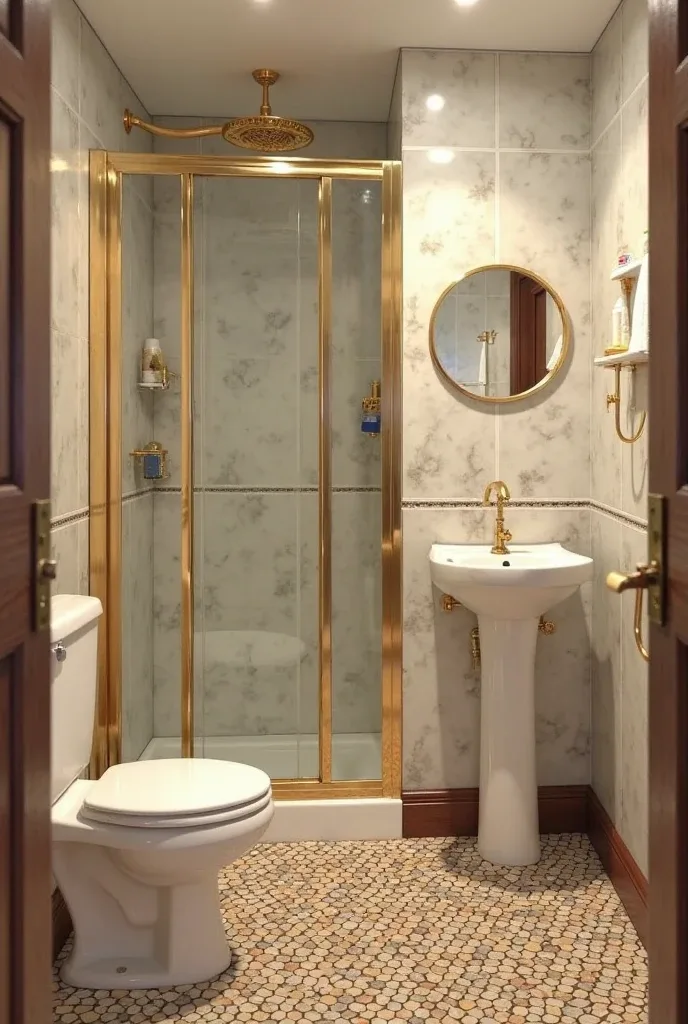
Vintage style can actually work beautifully in small bathrooms because it embraces the cozy, intimate feeling rather than trying to make the space feel larger than it is. Mosaic floor tiles add pattern and interest without overwhelming the small space.
A pedestal sink is classic and takes up minimal floor space, while sliding shower doors save the space that hinged doors would require to open. Brass fixtures and a round mirror complete the vintage aesthetic.
The key is choosing vintage elements that are appropriately scaled for the space. Oversized vintage fixtures will overwhelm a small room, but properly sized pieces create authentic period charm.
Dark Moody Micro Bathroom With Warm Lighting

Dark colors in small spaces can be incredibly sophisticated when done right. The trick is having excellent lighting to prevent the space from feeling like a cave. Under-cabinet lighting on a floating vanity creates ambient light that makes the dark surfaces feel warm rather than gloomy.
Gray stone tiles create a spa-like atmosphere, while the floating vanity keeps floor lines clean. A rain shower head adds luxury and makes the small shower feel more spacious.
This approach works especially well for people who find light, bright spaces too stark. The dark, cozy feeling can make a small bathroom feel like a relaxing retreat.
Concrete Box Bathroom With Built-in Fixtures
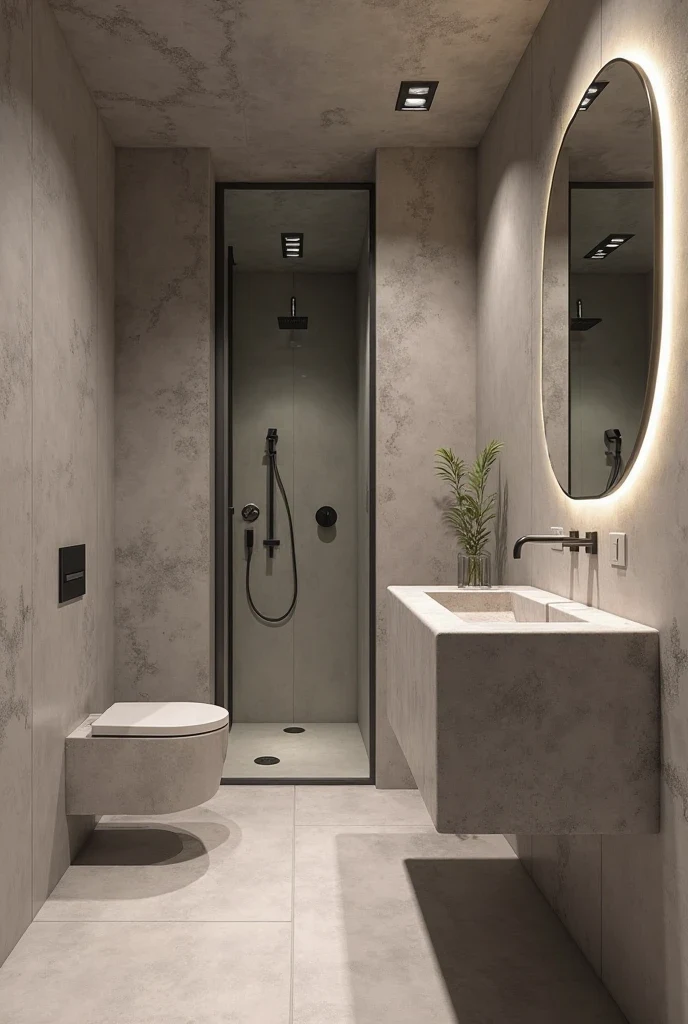
Concrete might seem like an unusual choice for a small bathroom, but when used skillfully, it creates a seamless, spa-like environment. Built-in concrete fixtures maximize space efficiency while creating a cohesive, high-end look.
The integrated sink and vanity eliminate the visual breaks that separate fixtures create, making the space feel larger and more unified. A flush glass shower panel maintains clean sight lines while containing the shower area.
This ultra-modern approach works best for people who love contemporary design and want their small bathroom to feel like a piece of architecture rather than just a functional room.
Beachy Compact Bathroom With Natural Textures
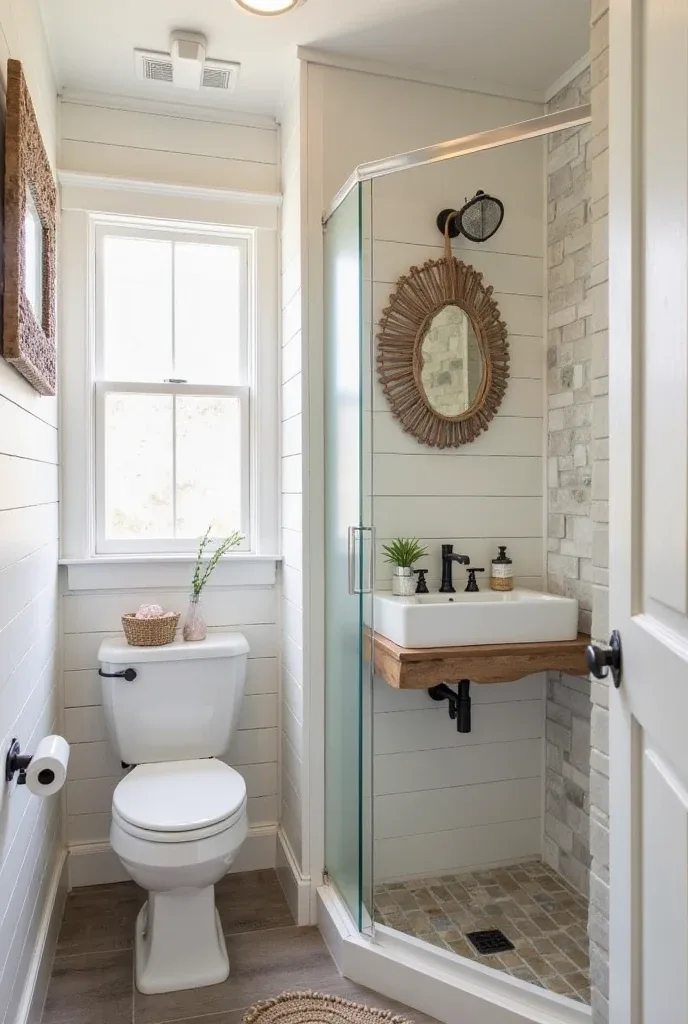
Coastal style brings a relaxed, vacation-like feeling that can make even the tiniest bathroom feel like a retreat. White shiplap walls add texture without overwhelming the space, while driftwood vanities bring natural warmth and character.
Natural textures like woven mirrors and stone tiles add visual interest without busy patterns that could overwhelm a small space. The key is keeping the color palette light and coastal—whites, soft blues, and natural wood tones.
This style works particularly well if your small bathroom feels dark or cramped. The beach-inspired elements create a light, airy feeling that makes the space feel more open.
Zen-Inspired Tiny Bathroom With Green Touches
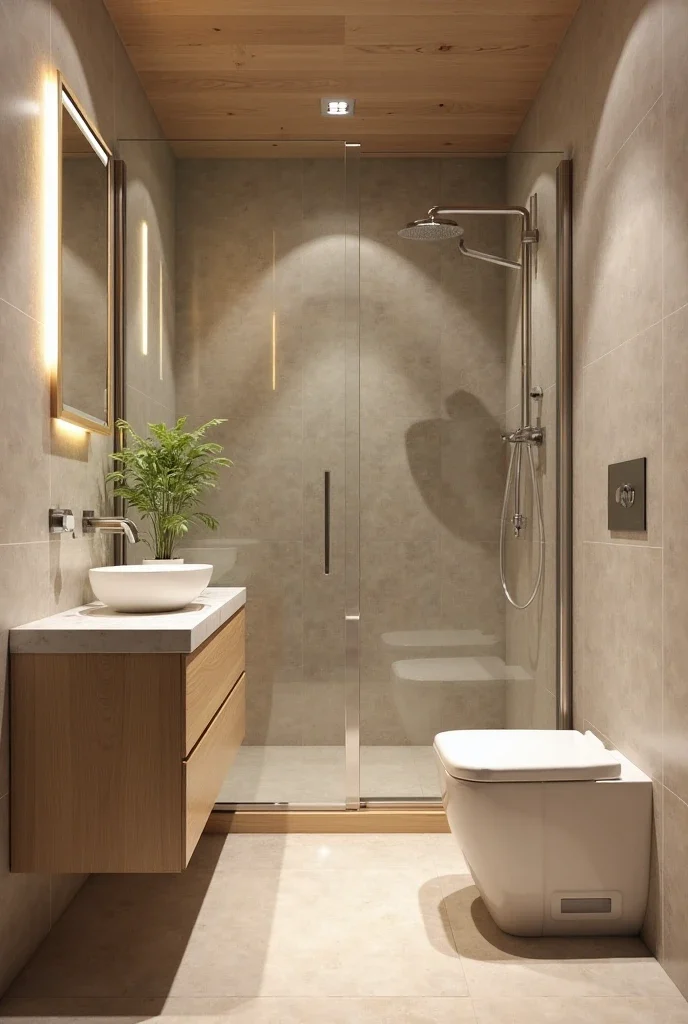
Japanese-inspired design principles are perfect for small bathrooms because they emphasize simplicity, functionality, and the beauty of natural materials. Light wood and stone create a peaceful, spa-like atmosphere.
A small plant adds life and freshness to the space without taking up precious counter room. The minimal aesthetic ensures that every element feels intentional and necessary rather than cluttered.
This approach is ideal for people who want their small bathroom to feel like a peaceful retreat from daily stress. The zen aesthetic promotes calm and relaxation even in the tiniest space.
High-Contrast Compact Bathroom With Patterned Floor
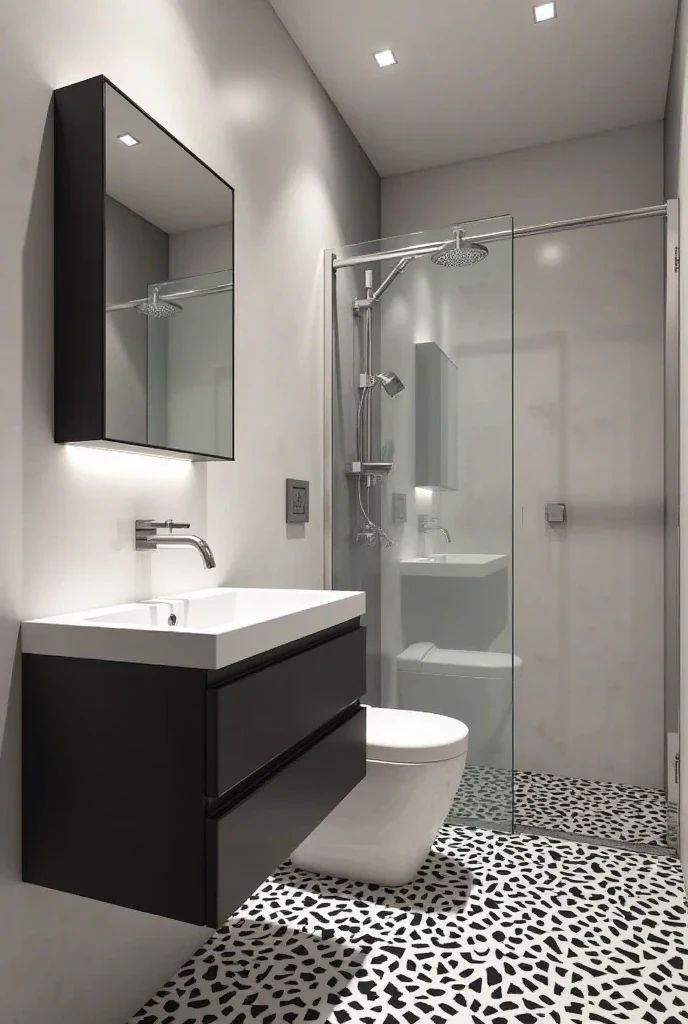
Sometimes a small bathroom benefits from one bold element that gives it personality and prevents it from feeling generic. Patterned floor tiles can add incredible visual interest without taking up any additional space.
Black and white patterns are classic and timeless, while the floating black vanity and chrome fixtures create a sophisticated, contemporary feel. The key is keeping everything else simple so the patterned floor can be the star.
This approach works well for people who want their small bathroom to have personality and style rather than just being purely functional. The bold floor pattern makes the space memorable and unique.
Final Thoughts
The most successful small bathrooms aren’t the ones that try to pretend they’re bigger than they are—they’re the ones that embrace their size and make every square inch count. Your tiny bathroom can be just as stylish and functional as any sprawling master suite; it just requires more thoughtful planning and smarter choices.
The best small bathroom designs feel intentional rather than compromised. When someone walks into your bathroom, they should think “wow, what a clever use of space” rather than “I wish this were bigger.” That’s the difference between a small bathroom that works and one that truly shines.
Remember, you’re not trying to fit everything a large bathroom has into a smaller space. You’re creating something completely different—something efficient, beautiful, and perfectly tailored to its size. Start with one or two ideas that speak to you, focus on getting the layout right, and build from there. Your small bathroom might just become your favorite room in the house.

